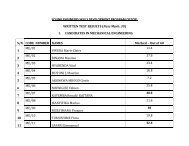lois et reglements police de roulage avec amendements
lois et reglements police de roulage avec amendements
lois et reglements police de roulage avec amendements
You also want an ePaper? Increase the reach of your titles
YUMPU automatically turns print PDFs into web optimized ePapers that Google loves.
nearest location in <strong>de</strong>fault of which the vehicle will be r<strong>et</strong>ained.<br />
Chapter 6. BRAKING<br />
Article 74:<br />
1. For the sake of provisions of this chapter:<br />
a) the term " axle wheels" means the symm<strong>et</strong>rical wheels at the median longitudinal plane of the<br />
vehicle, even when they are not placed on the same axle, a tan<strong>de</strong>m axle being counted for two<br />
axles.<br />
b) the term " in-service braking" <strong>de</strong>signates the <strong>de</strong>vice normally used for slowing down or<br />
stopping the vehicle.<br />
c) the term " parking brakes" <strong>de</strong>signates the <strong>de</strong>vice used for maintaining immobile the vehicle,<br />
in the absence of the driver, or in the case of a traller, when it is uncoupled;<br />
d) the term "emergency braking <strong>de</strong>signates the <strong>de</strong>vice used- for slowing down or stopping the<br />
vehicle in the event of the, in-service braking fallure;<br />
e) the term " traller " is only applicable to trallers meant for being coupled to an auto-mobile<br />
vehicle.<br />
2. Every vehicle or line of vehicles must be provi<strong>de</strong>d with a braking equipment sufficiently<br />
efficient to control movements, to stop it in a sure and quick manner and to prevent the spinning<br />
of the wheel or the wheels stopped, whatever be the loading conditions and the sharpness of the<br />
up or down slope.<br />
3. Automobile vehicles braking system:<br />
a) Every automobile vehicle must be provi<strong>de</strong>d with a braking system which can easily be<br />
handled by the driver without hin<strong>de</strong>ring the driving of the vehicle and ma<strong>de</strong> of¬<br />
10 in-service braking allowing to slow down the vehicle and to stop it in a sure, quick and<br />
efficient manner, in whatever conditions of loading and sharpness of the up or down slope of<br />
the way on which it is moving;<br />
2° a parking brake allowing to maintain the vehicle, whatever be the conditions of its loading on<br />
an up or down 16 % slope, the braking active surfaces being maintained in a tightening position<br />
by means of a <strong>de</strong>vice with purely mechanical action, even in the absence of the driver;<br />
3° an emergency braking to slow down or to stop the vehicle, whatever be the conditions of its.<br />
loading, within a reasonable distance, even in the event of in-service braking fallure.<br />
b) The braking <strong>de</strong>vices can so share parts that two commands at least remain in<strong>de</strong>pen<strong>de</strong>nt one<br />
from the other.<br />
c) The in-service braking must command all the vehicle wheels. However, on vehicles having<br />
more than two axles, the wheels of one axle may be in<strong>de</strong>pen<strong>de</strong>nt from the braking system.<br />
d). The in-service braking and the parking brakes have to command one wheel at least on each<br />
si<strong>de</strong> of the median longitudinal plane of the vehicle.<br />
e) The in-service braking and the parking brakes have to work on braked surfaces linked to<br />
wheels in a permanent way by means of sufficiently strong parts.<br />
f) No braked surface can be uncoupled from wheels except:<br />
1 ° When uncoupling is only temporary, especially during change of gears;<br />
2° Where for the parking brakes, uncoupling is not possible without the action of the driver;




